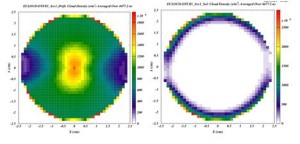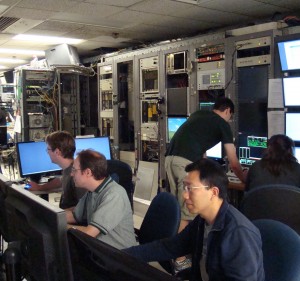The CesrTA (Cornell Electron Storage Ring Test Accelerator) collaboration at Cornell University, US, made important contributions to the design of the ILC damping rings for the recently completed Technical Design Report, including finding ways to reduce a phenomenon known as the electron cloud effect. Post-TDR, the collaboration is pursuing ways to make the damping rings even more effective by better understanding another phenomenon: intrabeam scattering.
A damping ring is a closed storage ring that decreases the volume of the particle bunches making up a beam, creating bunches that are denser and more compact. The ILC design has two damping rings, one for the electron beam and one for the positron beam. Each beam will pass through a damping ring prior to being sped through the main accelerator to the collision point.
Creating beams with compact particle bunches, or low emittance, is important to the ILC because compact bunches are required for high luminosity. Luminosity is proportional to the electron-positron collision rate in the accelerator.
“One goal of the linear collider is to produce a lot of Higgs particles,” said David Rubin, principal investigator of the CesrTA research program. “To produce a lot of Higgs particles, you need to have a lot of collisions, which means you need to have a high luminosity.”
The ILC has both a target vertical emittance and a target beam current, which is another factor involved in increasing luminosity. The target vertical emittance is 2 picometre·radians, and the target beam current is approximately 400 milliamps.
When designing the damping rings for the Technical Design Report, one major issue the CesrTA collaboration had to deal with is known as the electron cloud effect, which primarily affects the positron beam.
This effect occurs when radiation from the beam particles hits the walls of the ring’s vacuum chamber, the tube through which the beam runs, and dislodges electrons. The electrons interfere with the positron beam, which results in increased bunch size, lower particle density and reduced accelerator performance.
CesrTA researchers tested sections of vacuum chamber with different mitigations, or methods for reducing the electron cloud. These mitigation techniques include different vacuum chamber coatings, such as titanium-nitride, and different vacuum chamber geometries, such as grooves. Other mitigations include inserting clearing electrodes, which remove electrons from the chamber, and applying a longitudinal magnetic field, which keeps the electron cloud near the vacuum chamber wall and away from the beam. Measurements from these tests allowed the researchers to calculate whether they could design a vacuum chamber to meet ILC emittance and beam current specifications.

These graphics show electron cloud density in a vacuum chamber. A vacuum chamber with a significant electron cloud effect (left) is shown compared to one with a reduced electron cloud effect (right). In this graphic, the cloud was reduced using a longitudinal magnetic field, one of the many mitigation techniques tested by CesrTA researchers. Image courtesy of Jim Crittenden
“At the beginning of the CesrTA program, there was a lot of uncertainty about whether the damping ring that was required could actually be made to work,” Rubin said. “I think now we’ve demonstrated how to do it, and we can say with some confidence that it will work.”
The CesrTA collaboration is currently in Phase II of their damping ring R&D programme, which began in 2011 and will continue through 2014. In the past year, CesrTA researchers have moved their focus from the electron cloud issue to another factor limiting the density of particle bunches: intrabeam scattering.
In intrabeam scattering, the particles in a bunch of positrons or electrons scatter off one another, limiting their ability to be squeezed into a dense bunch. This phenomenon is specific to beams that are already compact and high-density.
“It will eventually be the limiting factor (of beam size) once we get rid of the electron cloud,” said Jim Crittenden, a research associate in the CesrTA research programme.
To understand intrabeam scattering, researchers need to make precise measurements of individual particle bunches.
“We need to measure the vertical size, the horizontal size and the length of the bunch,” Rubin said. “At the Cornell storage ring, we have developed instruments that allow us to do this.”
After that, researchers will determine how beam energy affects intrabeam scattering.
“By pursuing these other effects now, we’re exploring the possibility that the damping ring might be specified in a different way, perhaps with an even lower emittance or a higher current,” Rubin said. “But that requires a deeper understanding of all of these effects.”


Recent Comments